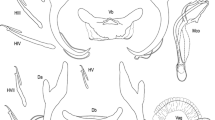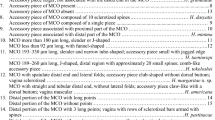Abstract
Haliotrema nanhaiense n. sp. and Haliotrema triostegum n. sp. are described respectively from the gills of Acanthurus nigrofuscus (Forsskål) and Acanthurus triostegus (Linnaeus) in the South China Sea. Haliotrema nanhaiense n. sp. differs from other existing congeneric species by its male copulatory complex, comprising a C-shaped copulatory tube, a saucer-shaped base and a sickle-shaped accessory piece. Haliotrema triostegum n. sp. can be differentiated from all other members of Haliotrema by having a unique copulatory complex, a cup-shaped base, inverted L-shaped copulatory tube with a small sclerotised piece arising from its distal portion, and a large accessory piece from the proximal portion of copulatory tube.


Similar content being viewed by others
References
Dang, B. T., Levsen, A., Schander, C., & Bristow, G. A. (2010). Some Haliotrema (Monogenea: Dactylogyridae) from cultured grouper (Epinephelus spp.) with emphasis on the phylogenetic position of Haliotrema cromileptis. Journal of Parasitology, 96, 30–39.
Froese, R., & Pauly, D. (2014). FishBase. World Wide Web electronic publication. www. fishbase. org. Accessed 9 July 2014.
García-Vargas, F., Fajer-Ávila, E., & Lamothe-Argumedo, R. M. (2008). Two new species of Dactylogyridae (Monogenoidea) on rose spotted snapper, Lutjanus guttatus (Osteichthyes: Lutjanidae), from the coasts of Nayarit and Sinaloa, Mexico. Zootaxa, 1729, 61–68.
Kearn, G. C. (1971). The attachment of the ancyrocephalid monogenean Haliotrema balisticus to the gills of the trigger fish, Balistes capriscus (= carolinensis). Parasitology, 63, 157–162.
Klassen, G. (1994a). Phylogeny of Haliotrema species (Monogenea, Ancyrocephalidae) from boxfishes (Tetraodontiformes: Ostraciidae): are Haliotrema species from boxfishes 500 monophyletic? Journal of Parasitology, 80, 596–610.
Klassen, G. (1994b). On the monophyly of Haliotrema species (Monogenea, Ancyrocephalidae) from boxfishes (Tetraodontiformes: Ostraciidae): relationships within the Bodiani group. Journal of Parasitology, 80, 611–619.
Kritsky, D. C., & Boeger, W. A. (2002). Neotropical Monogenoidea. 41: New and previously described species of Dactylogyridae (Platyhelminthes) from the gills of marine and freshwater perciform fishes (Teleostei) with proposal of a new genus and a hypothesis on phylogeny. Zoosystema, 24, 7–40.
Kritsky, D. C., & Stephens, F. (2001). Haliotrema abaddon n. sp. (Monogenoidea: Dactylogyridae) from the gills of wild and maricultured West Australian dhufish Glaucosoma hebraicum (Teleostei: Glaucosomatidae), in Australia. Journal of Parasitology, 87, 749–754.
Kritsky, D. C., Yang, T. B., & Sun, Y. (2009). Dactylogyrids (Monogenoidea, Polyonchoinea) parasitizing the gills of snappers (Perciformes, Lutjanidae): Proposal of Haliotrematoides n. gen. and descriptions of new and previously described species from marine fishes of the Red Sea, the eastern and Indo-west Pacific Ocean, Gulf of Mexico and Caribbean Sea. Zootaxa, 1970, 1–51.
Mendoza-Franco, E. F., & Violante-González, J. (2011). Two new species of Haliotrema (Monogenoidea: Dactylogyridae) from Cirrhitus rivulatus (Perciformes: Cirrhitidae) from the Pacific coast of Mexico. Journal of Parasitology, 97, 800–804.
Mizelle, J. D. (1936). New species of trematodes from the gills of Illinois fishes. American Midland Naturalist, 17, 785–806.
Mizelle, J. D., & Price, C. E. (1963). Additional haptoral hooks in the genus Dactylogyrus. Journal of Parasitology, 19, 1028–1029.
Sun, Y. (2007). Studies on the fauna and molecular phylogeny of some monogeneans from the fishes off the north part of South China Sea. PhD Thesis, Sun Yat-Sen University, Guanghzou, 264 pp.
Sun, Y., Gibson, D., & Yang, T. B. (2011). Species of Haliotrema Johnston & Tiegs, 1922 (Monogenea: Dactylogyridae) from Zanclus cornutus (L.) (Teleostei: Zanclidae) and Acanthurus nigrofuscus (Forsskål) (Teleostei: Acanthuidae) in the South China Sea. Systematic Parasitology, 79, 213–225.
Sun, Y., Kritsky, D. C., & Yang, T. B. (2007). Two new species of Haliotrema (Monogenoidea: Dactylogyridae) from Acanthurus nigrofuscus and Acanthurus olivaceus (Teleostei: Acanthuridae) in the South China Sea. Journal of Parasitology, 93, 781–786.
Sun, Y., Li, M., & Yang, T. B. (2014). Studies on Lethrinitrema Lim & Justine, 2011 (Monogenea: Dactylogyridae), with the description of two new species, a key to the genus and a phylogenetic analysis based on rDNA sequences. Systematic Parasitology, 88, 119–139.
Wu, X. Y., Zhu, X. Q., Xie, M. Q., & Li, A. X. (2006). The radiation of Haliotrema (Monogenea: Dactylogyridae: Ancyrocephalinae): molecular evidence and explanation inferred from LSU rDNA sequences. Parasitology, 132, 659–668.
Wu, X. Y., Zhu, X. Q., Xie, M. Q., & Li, A. X. (2007). The evaluation for generic-level monophyly of Ancyrocephalinae (Monogenea, Dactylogyridae) using ribosomal DNA sequence. Acta Zootaxonomica Sinica, 28, 24–29.
Yamaguti, S. (1953). Parasitic worms mainly form Celebes. Part 2. Monogenetic trematodes of fishes. Acta Medicinae Okayama, 8, 203–256.
Yamaguti, S. (1968). Monogenetic trematodes of Hawaiian fishes. Honolulu: University of Hawaii Press, 287 pp.
Yang, T. B., Kritsky, D. C., & Sun, Y. (2004). Revision of Allobenedenia Yamaguti, 1963 (Monogenoidea: Capsalidae) with the description of A. zhangi n. sp. from Epinephelus fasciatus (Teleostei: Serranidae) in the South China Sea. Systematic Parasitology, 59, 223–233.
Young, P. C. (1968). Ten new species of Haliotrema (Monogenoidea: Dactylogyridae) from Australian fish and a revision of the genus. Journal of Zoology, 154, 41–75.
Zhukov, E. V. (1980). Monogenea of the genus Haliotrema Johnston et Tiegs, 1922 from the gills of fishes fam. Holocentridae and fam. Acanthuridae of the Gulf of Mexico. Parazitologiya, 29, 41–52.
Funding
This research was financially supported by the National Natural Science Foundation of China (31072215, 41106129 and 31472284).
Conflict of interest
The authors declare that they have no conflict of interest.
Compliance with ethical standards
All applicable institutional, national and international guidelines for the care and use of animals were followed.
Author information
Authors and Affiliations
Corresponding author
Rights and permissions
About this article
Cite this article
Sun, Y., Yang, C. & Yang, T. Two new species of Haliotrema Johnston & Tiegs, 1922 (Monogenea: Dactylogyridae) from Acanthurus nigrofuscus (Forsskål) and A. triostegus (Linnaeus) (Teleostei: Acanthuridae) in the South China Sea. Syst Parasitol 91, 253–259 (2015). https://doi.org/10.1007/s11230-015-9575-y
Received:
Accepted:
Published:
Issue Date:
DOI: https://doi.org/10.1007/s11230-015-9575-y




